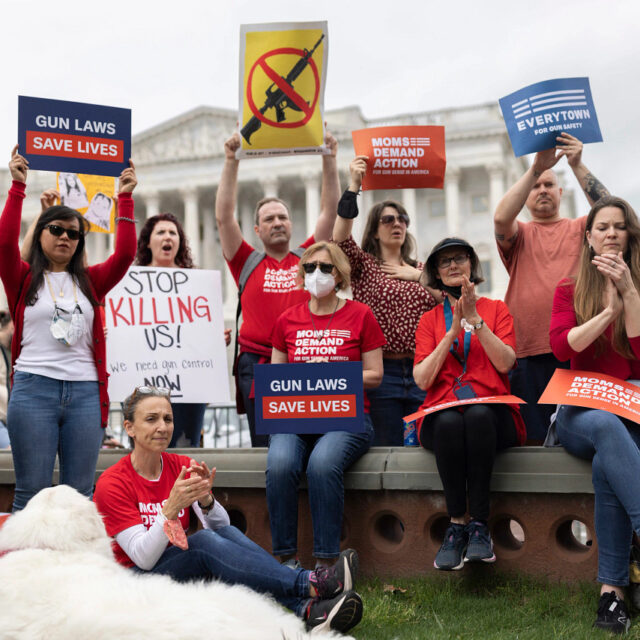Iowa has passed critical gun safety laws that protect domestic violence victims from their abusers, including recent bipartisan legislation to ensure many abusers must turn in any firearms after assault convictions and while under domestic violence restraining orders.
Iowa has long been a leader in requiring background checks for all handgun sales: For forty years, Iowa has required all handgun purchasers to pass a background check and obtain a permit from law enforcement. The permit requirement goes far beyond the federal background check law—and means that prohibited abusers in Iowa can’t arm themselves illegally by skipping a background check altogether.
Background checks work to stop abusers from acquiring guns: In the last twenty years alone, nearly 3,000 sales to domestic abusers have been blocked in Iowa.
In 2010, the Iowa General Assembly passed a law prohibiting abusers from having firearms after a domestic abuse misdemeanor and during a domestic violence restraining order, and requiring those abusers to surrender any firearms in their possession.
The bill had strong bipartisan support, with the Senate voting 36-12 and the House voting 73-25. Iowa is one of only 15 states to require firearm surrender for these domestic abusers.
States like Iowa that have require abusers subject to domestic violence restraining orders to relinquish their firearms saw a 14-16 percent lower intimate partner firearm homicide rate and a 10-12 percent lower intimate partner homicide rate.
Iowa’s concealed carry permitting laws disqualify any person convicted of a serious or aggravated misdemeanor within the past 3 years—including offenders who attack their girlfriends. The system also empowers law enforcement to deny permits to people who raise red flags they would be a danger to self or others with a firearm in public.
Despite Iowa’s history of passing strong gun safety protections for domestic abuse victims, the state continues to have a “boyfriend loophole”—failing to protect victims simply because of their marital status, even though unmarried Iowans are at far greater risk than their married counterparts.
- This gap in Iowa law, which matches the gap in federal law, has become increasingly deadly: The nationwide share of homicides committed by dating partners has grown over three decades, and now American women are as likely to be killed by dating partners as by spouses.
- From 2013 to 2017, 37 Iowa women were killed by intimate partners. Sixty-five percent of these homicides were committed by dating partners—making Iowa women nearly twice as likely to be killed by a dating partner than by a current or former spouse.
- The elevated risk for Iowa women in abusive dating relationships is even more dramatic when it comes to assaults: Among all aggravated assaults in Iowa, two times as many incidents were committed by a boyfriend or a girlfriend, compared with assaults committed by a current or former spouse.
There were nearly 7,500 aggravated assaults committed by a dating partner in Iowa over the last five years.
According to the most recent data from the state Department of Public Safety, twice as many domestic abuse incidents in Iowa occurred in boyfriend-girlfriend relationships compared with married couples.
Research shows that closing the boyfriend loophole works to save women’s lives.
When states expanded their firearm prohibition laws beyond federal law to cover abusive dating partners, they experienced a 16 percent reduction in intimate partner firearm homicide rates and a 13 percent reduction in intimate partner homicide rates.
Along with Iowa’s boyfriend loophole, the state also has a “stalker loophole”—which allows convicted misdemeanor stalkers to purchase and possess firearms.
Misdemeanor stalker offenders are not prohibited from possessing firearms under Iowa law—though they are barred from obtaining a concealed carry permit.
One study found that 76 percent of intimate partner homicides and 85 percent of attempted homicides of women were preceded by at least one incident of stalking in the year before the attack. Nearly one in every six women in Iowa report being stalked during her lifetime.
Recent horrific homicides illustrate the danger Iowa women face from abusive boyfriends.
- In 2014, an Estherville mother of four was shot and killed by her boyfriend in front of her house, where she died in her mother’s arms. Her children reported that the killer had been abusive to the victim.
- An Evansdale woman was shot and killed in 2012 by an ex-boyfriend who was jealous of a new relationship. Before the murder, she told friends and family that she was being stalked.
- In 2018, a Webster City woman was killed by her boyfriend. Authorities believe the killer had been physically abusive for a year and a half, and family members reported he stalked her.
- A Waterloo woman was shot and killed in 2015 by her boyfriend of several years. In a 2016 incident in Freeport, a woman was shot and killed by her ex-boyfriend shortly after the couple broke up.
Intimate Partner Homicides
Source: Everytown for Gun Safety analysis; Uniform Crime Reporting Program: Supplementary Homicide Reports.
Intimate Partner Aggravated Assaults


